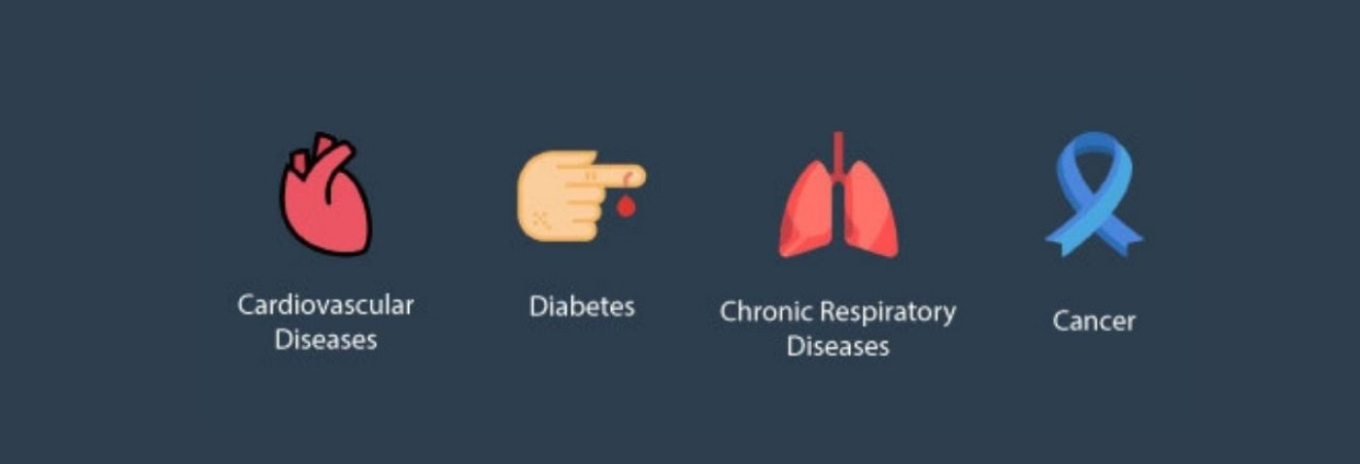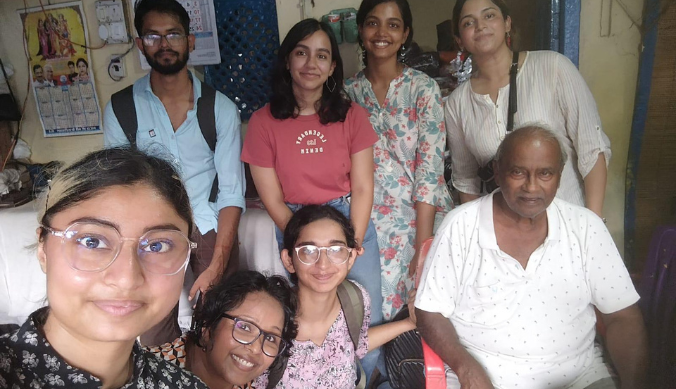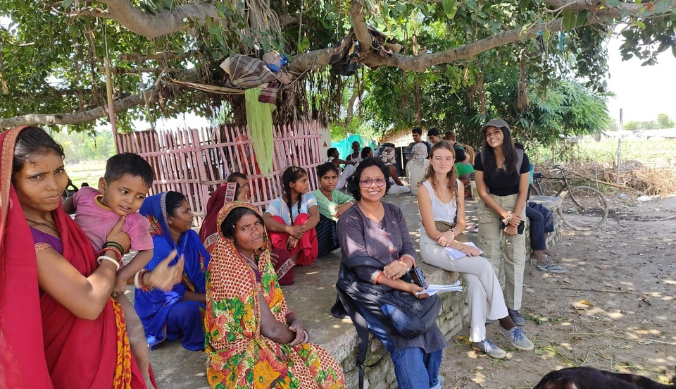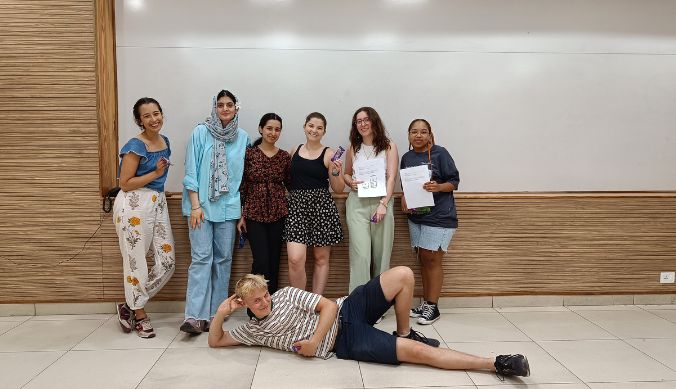Non-Communicable Diseases and their burden in India
This Focused Interaction session examines the burden of NCDs in India, their linkages with food and nutrition, the underlining challenges, and the overall policy ecosystem governing NCDs in India.

Office of PR & Communications
13 January, 2022 | 4m readNon-Communicable diseases (NCDs) are a group of diseases that affect individuals over an extended period of time causing socio-economic burden to the nation (WHO). They are chronic in nature and are a result of a combination of genetic, physiological, environmental and behavioural factors. According to WHO (2021), NCDs account for 64% of the disease burden in India. “Increasing longevity, unhealthy diets and sedentary lifestyles have led to an increase in NCDs such as heart disease, diabetes and cancers in India”.
SPI took an initiative to examine the burden of NCDs in India, their linkages with food and nutrition, the underlining challenges, and the overall policy ecosystem governing NCDs in India. In collaboration with The George Institute for Global Health (TGI) – India, a ‘Focused Interaction’ session was conducted with an expert, Dr. Praveen Devarsetty, Program Head, Primary Healthcare at TGI – India.
Excerpts from the discussion
Could you please throw some light on the challenges of managing NCDs in India and the impact of Covid-19 on the NCD care?
When we talk of NCDs and their risk factors, mostly cardiovascular diseases, diabetes, and hypertension, we primarily focus on 3 or 4 areas: (i) early identification of NCDs. These diseases are silent diseases. It is difficult for people to know that they are suffering from them until they are at later stages and have developed complications. So, early identification is key. (ii) is referral- How do you refer them to doctors and then ensure that they have received the appropriate care? The (iii) part is management. So, once the patient goes to any health facility, how are these facilities managed- primary healthcare doctors are usually busy either with managing patients or engaged with administrative responsibilities. How do you support them in this task? and (iv), that I personally feel is the major influencer is adherence to medication. We all know that chronic diseases require a life-long course of medication. People stop taking antibiotics, which is usually two tablets daily, once they feel better. How do we then ensure that people take medicines for a disease which they do not feel is a problem? Daily wage labourers and workers might take the medication for a month when they are detected with the disease, but they don’t usually go for a refill or for a follow-up.
So, this is what was happening before COVID. Many activities were taking place to ensure that people were identified, referred and adequately managed. One of them is 104 services in Andhra Pradesh- an ambulance system that goes from village to village every month to measure blood pressure and diabetes. This is a government initiative, and they also give medications at the doorstep. Another model involves ASHA workers and ANMs. These frontline health workers are also given some additional responsibilities for screening hypertension and diabetes, and they help in awareness generation within the communities.
Now, in the COVID era, the entire focus shifted on managing COVID It was a knee jerk reaction. COVID is a new disease, there were no management protocols in place and no guidelines to protect our own health systems. And I think the most affected among all services were maternal and child-care and NCDs. In maternal and childcare deliveries were taking place at government hospitals but appropriate care and management took a backseat.
When it came to NCDs, it was one of the most neglected areas. There was no new diagnosis or follow up, and severe supply chain issues in medicines- so, there was a big problem in the continuation of medication. If you ask me what took a major brunt, I will say many patients stopped taking medication for a finite period of time, leaving aside early detection and other components.
You mean that stopping the medication, for even a small period of time, can have serious outcomes. That implies that late diagnosis could also have life-threatening consequences. Is that the case?
Yes, Both delayed diagnosis and frequent skipping of doses of blood pressure medication, can often let hypertension go out of control. Strict blood pressure control helps prevent serious health conditions, including heart attack, stroke, kidney disease, and congestive heart failure. The same is true for diabetes. In a study in Italy, in comparison to people who rarely took their prescribed daily drugs, patients who used the pills 26 percent to 50 percent of the time were 17 percent less likely to be hospitalized for heart failure. The risk was 34 percent lower for individuals who took their medicine at least 75 percent of the time.
Do you think that the existing data on NCDs at the national and sub-national levels is sufficient to evaluate and assess the impact of burden?
Unfortunately, when we talk of primary health care facilities and then when we talk about data, it doesn’t match. We have seen doctor’s writing prescriptions on a slip of paper and giving them to the patients. In some states, we have systems and records to collect the information, but there is still a long way when these records can become electronic records – something that could be tracked in real-time for NCDs?
As per the NPCDCS program ( National Program for prevention and control of cancer, diabetes, cardiovascular disease and stroke), the government does emphasize house-to-house screening for hypertension and diabetes and because of that, we do know the prevalence of hypertension and diabetes in our communities. But do we know anything further than that? How many have taken a doctor’s consultation following identification? How many of them are on medications; how many are being followed up? What is happening to these people? Are the BP levels coming down, are the sugar levels coming down. Wouldn’t it be great to know about these things and adapt our management accordingly.
Our health systems are wonderful! I have been working with health systems in many countries and the kind of penetration our Primary Healthcare system has is fantastic – 1 subcenter for every 5000 population; one primary center for every 30,000 of population-we don’t find such facilities in many countries. But when the data is lacking, then how do we know whether the approach which we are taking is working or not? Apart from the lack of prevalence of adequate data, we have limited information for health system performance or follow up care data for every individual, and over time we will need to have that.
Is there a way to delay the risk of developing or preventing NCDs?
Healthy dietary patterns and physical activity are consistently associated with reduced risk across all the NCD categories. Air pollution and smoking are also responsible for an increase in NCDs. High blood pressure and obesity are other important risk factors that are responsible for an increased risk of cardiovascular diseases and other NCDs.
Since the diet is an important aspect to factor in while talking about the prevention of NCDs, could you please take us through the challenges of nutrition in India?
The National Family Health Survey publishes data that reports food consumption patterns from different geographic locations. So, in the latest report, I think they did mention that there is an unbalanced diet, especially in women, and their diet do not contain fruits, vegetables, pulses, meat or milk products which are necessary to lead a healthy life.
The targeted public distribution system (PDS) that we have, supplies rice and in some states PDS provide pulses, but this is not uniform. This is taking place to combat the food security issue. But it is important, that along with food security, we also consider dietary diversity, and are not only dependent on starchy staples. Nobody talks about pulses being a part of PDS, which is a big problem.
We need to ensure that the people get some amount of proteins, fruits and vegetables in their diet. Consuming carbohydrates alone could only lead to specific nutrition-related diseases such as for overweight and obesity, but which could also be a precursor for other chronic diseases like cardiovascular disease, cancer, diabetes.
Any global best practices, especially those practised in the emerging economies, that you feel are important learnings for India? Could something be started on a pilot scale in India or perhaps in the Indian states to ensure healthy diet and nutrition among the population ?
There are country-specific dietary guidelines in India. We are working in front of package labeling so labeling legislation is also available. Media campaigns are promoting healthy diets. So, all of these are available in many countries and we can definitely have some learnings.
When we talk of dietary guidelines, you’ll be surprised to note that in India we talk of only two dietary guidelines. One -the dietary guidelines for Indians by the National Institute of Nutrition, which was last published in 2011 and the other is by the National Nutrition Service.
It’s unfortunate that in such a huge country, we don’t have region-specific guidelines. Diet patterns usually change from district to district, and I think, it might be useful to have dietary guidelines in place that suit the local context – make it more feasible for the population to follow.
You mentioned about the work being done in the area of ‘the front of package labelling (FOPL)’. Could you please elaborate a bit?
Initially within the government scheme, a ‘back of label’ was introduced where there is MRP, the expiry dates etc. But then, the front of pack labelling movement came into existence: advocacy organisations that spelled out the consumers’ liability to understand the nutritional composition of different packaged food products and if some sort of guide could be provided on the products. That’s how the FOPLs started and got implemented in many countries. There are around 30 countries that have FOPL guidelines that show us the constituents within that package, but it is mandatory only in a few of them (e.g., Chile, Ecuador, Sri Lanka).
Mostly, FOPLs can be nutrient-specific labels that display information about the content of a particular nutrient and summary labels that provide an assessment of the overall nutritional value. Some of the FOPLs are reductive- they display a reduced version of the nutrition information present on the nutrition information panel without providing any interpretation (e.g., reference intake). Some are interpretive FOPLs- they use simple designs to display the information present in the nutrition information panel in terms of the products’ health value. The panel considers all the components and gives one kind of picture that- this is good for your health or not good for your health.
The Government of India is currently considering the introduction of a FOPL to help consumers make healthier food choices to assist in addressing substantial levels of under- and over-nutrition. The FSSAI which is responsible for FOPLs did venture into having one uniform FOPL for India. The draft regulations have not been ratified, due in part to resistance from food companies who argue ‘red’ signified danger, fearing that this would give consumers the impression that they were consuming toxic food. So that’s how we are still lurking.
Because our population is so diverse, there is a need to understand whether FOPLs could be easily understood by the population in large and whether it influences our food choices.
In our study, we worked with the draft FSSAI label in addition to five or six other FOPLs from other countries. We checked for the acceptability and understandability of these FOPLs by community members and performed comparative effectiveness of the performance of these FOPLs in North and South India involving population from urban, urban slum and rural areas. We have just completed the data collection and we are still analysing the data. There are other organizations that are also conducting similar studies to see which FOPL is good. While there is a lot of industry influence, it’s important for us to contribute to evidence and that’s the path that we are taking.
Another thing to consider is that in our general population, packaged food intake is usually very low compared to our total food intake and most part of our food is loose or cooked food. So, we also don’t know how influential or how effective the FOPL would be for making healthy choices. It would be effective in urban places and in high and mid economic status. But what about the other 70% of our population? These are some of the insights that we would need to consider before developing an intervention.
My idea is to agree with a FOPL, start implementing it, and then work towards creating awareness about it in the population. Maybe, we can bring in influencers like filmstars, or some big leaders and ask them to talk about FOPLs, how to understand FOPLs. If you see green- it’s a good product. If you see red -think about it, that sort of communication needs to go out simultaneously as we launch the FOPL.
How do we create more awareness among the students in schools, colleges, universities in this area?
I feel that from the school level there is not much of a focus on food and health. We talk about reproductive health, right? This was to ensure that students understand that it’s not a hush-hush topic, but something that can be discussed. In the same way- can we have something in relation to diet and nutrition in school? to start inculcating a healthy habit.
It’s not only the responsibility of the parents. The school, the peers, the society- all influence a person. So, in the school curriculum, when the students are stuydying about the food pyramid where it discusses types of food-carbohydrates, proteins, fats- the curriculum should also talk about health, nutrition, physical activity, what needs to be avoided, what is to be taken- Issues around salt and junk food etc. I think that would be an early start for us.
Uh, and then of course, when we talk of academic institutions, I was surprised that there are not many courses in India to address dietetics research. We have dietetics courses running in several educational institutions, which is fantastic, but could we also have some specific courses, programs or even laboratories to improve research in this field.
Any suggestions on the policy front to curb the spread of NCDs in India?
For effective delivery of NCD care at the primary care level, strategic planning might be required. One solution does not fit all. For e.g. different types of NCDs are grouped within the current national programme, yet it may not make sense to approach them with a common strategy in the field. For examples, the approaches used to prevent hypertension and those to prevent cancer can be very different.
Importance needs to be given to multisectoral coordination. NCD prevention requires influence and cooperation of policy, academia, legislation, urban planning, environment and food industry and should not be thought of as a responsibility of only the health sector.
And finally, another area for development is building capacity for implementation research around the prevention and promotion of NCDs. Currently, the focus is mainly on the therapeutic/curative side. Research in understanding the role of front line health workers in managing NCDs, reducing the burden of the PHC doctors (task sharing/shifting) and the role of technology to facilitate such approaches could be studied. Similarly, health system redesigning for health promotion, prevention, and in particular, non-medical interventions for managing and preventing NCDs can be studied.
(the views presented in this section are that of the expert)













